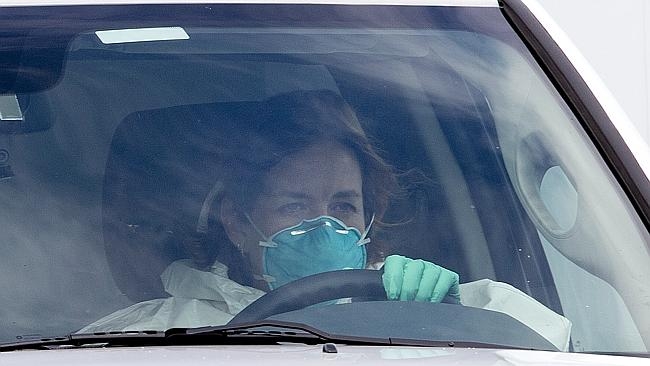
FIVE days ago, American doctor Kent Brantly thought he was going to die after being stricken with the deadly Ebola virus.
The 33-year-old, who contracted the virus from a colleague in Liberia, even called his wife from Liberia to say goodbye.
But just hours earlier, the highly experimental drug ZMapp had been delivered to the clinic where Brantly and fellow Samaritan’s Purse aid worker Nancy Writebol were being treated for Ebola.
The secret serum was delivered in subzero temperatures and with clear instructions — allow the vials to thaw naturally before administering.
With time running out, Brantly and Writebol had to decide if they wanted to be treated with the serum.
It was a huge risk — the experimental drug had been trialled on monkeys and seemed to work, but it had never before been tried on humans.
But knowing they were on the verge of death, both Americans gave their consent to be treated.
During the agonising eight-hour wait for the serum to thaw, Brantly told 59-year-old Writebol that she shoud have the first dose, CNN reports.
But as Brantly’s condition began to rapidly deteriorate, he asked for Writebol’s thawed medication. Doctors describe what happened next as “miraculous”.
Within just an hour of receiving the secret serum, Brantly’s condition made a dramatic turnaround.
His breathing improved and the rash that covered the upper part of his body started to fade away.
Incredibly, he was able to shower on his own the next morning before boarding the specially equipped Gulfstream jet that would take him to Atlanta, Georgia.
He was even able to walk off the ambulance as he arrived at Emory University hospital, becoming the first patient infected with the Eobla viursi to set foot in the US.

Writebol, who also received the serum, has departed Liberia airport and will soon join Brantley in Atlanta.
So what is the secret serum that has saved the lives of the two Americans?
As there is no proven treatment and no vaccine for Ebola, this experimental drug is raising lots of questions.

HOW DOES THE DRUG WORK?
The treatment works by preventing the Ebola virus from entering and infecting new cells.
The cocktail of antibodies does the work of the immune system when it is injected into infected patients.
WHAT’S THE CONTROVERSY?
The process by which the ZMapp medication was made available to Brantly and Writebol was highly unusual.
The World Health Organisation and Médecins Sans Frontières have cautioned that health authorities should not be using untested drugs in the middle of an outbreak due to scientific and ethical implications.
ZMapp has not been approved for human use and has not even undergone a clinical trial process.
WHO CREATED THE SERUM?
The drug was developed by the San Diego biotech firm Mapp Biopharmaceutical Inc, which has been working to create an Ebola treatment for several years, says CNN.
According to Mapp Biopharmaceutical’s website, the company was founded in 2003 “to develop novel pharmaceuticals for the prevention and treatment of infectious diseases, focusing on unmet needs in global health and biodefence”.
Both Brantly and Writebol were told that the treatment had never been tried before in a human being but had shown promise in small experiments with monkeys.
HOW WAS THE SERUM DEVELOPED?
The medicine is a three-mouse monoclonal antibody, meaning that mice were exposed to fragments of the Ebola virus and then the antibodies generated within the mice’s blood were harvested to create the medicine, CNN reports.
Researchers injected mice with the Ebola glycoprotein and then fused individual antibody-producing cells with a cancer cell, says Ars Technica’s science editor John Timmer.
Mapp then cloned the genes for these antibodies and then swapped out parts, replacing parts of the mouse version with the human portion of the same gene.
The researchers then needed to produce the antibodies in large quantities so they managed to insert the genes into cells from a tobacco plant, Timmer writes.
Mapp has been pursing that testing, starting in mice and working its way up to primates.
WHY DID TWO AMERICANS GET THE DRUG?
The process by which the medication was made available to Kent Brantly and Nancy Writebol was highly unusual and may have fallen under the US Food and Drug Administration’s “compassionate use” regulation.
The World Health Organisation says it was not involved in the decision to treat Brantly and Writebol. Both patients had to give consent to receive the drug, knowing it had never been tested in humans before.

WILL THE DRUG BE AVAILABLE TO OTHER EBOLA PATIENTS?
Dr Anthony Fauci, director of the National Institute of Allergy and Infectious Diseases, told CNN that scientists have to be careful about assuming this drug will work in other patients as it appears to have worked in Brantly.
“Having worked with administering antibodies for people for a really long time, that would be distinctly unusual,” he told CNN. “As we all know in medicine … you have to withhold judgment.”
The company has very few doses ready for patient use, Fauci said.
COULD THIS DRUG STOP THE EBOLA EPIDEIC?
An effective Ebola drug could help doctors treat the deadly virus, but a vaccine — given to healthy people to prevent them from ever becoming infected — would be a much more effective tool in stopping this, and future, epidemics.
